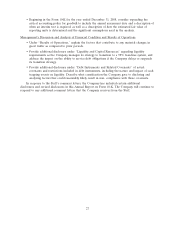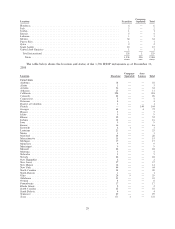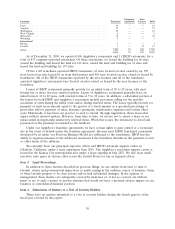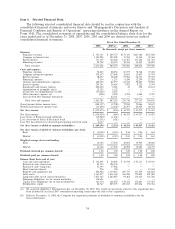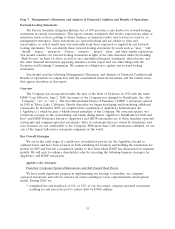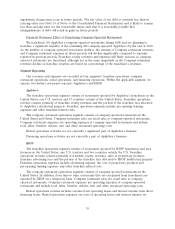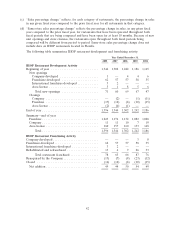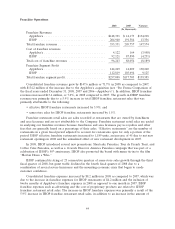IHOP 2008 Annual Report Download - page 50
Download and view the complete annual report
Please find page 50 of the 2008 IHOP annual report below. You can navigate through the pages in the report by either clicking on the pages listed below, or by using the keyword search tool below to find specific information within the annual report.
• franchised 103 restaurants in the California, Nevada, Delaware and Texas markets resulting in
cash proceeds used to reduce debt by $47.0 million; and
• completed the sale-leaseback of our restaurant support headquarters in Lenexa, Kansas,
resulting in cash proceeds of $39.0 million.
We have agreements to franchise an additional seven company-operated restaurants in the first
fiscal quarter of 2009; the franchising of five of these was completed on February 24, 2009. We are
actively engaged with several interested buyers for each of Applebee’s remaining company-operated
restaurants, except for a number of locations we intend to keep as research and development locations
in the Kansas City market. We are aiming to franchise approximately 200 restaurants in 2009 with the
reminder being franchised in 2010. These two initiatives and the strategic emphasis on franchising going
forward are designed to reduce the operating and overhead costs attributable to the domestic company-
operated restaurants and reduce the capital requirements needed to operate the business.
Energize the Applebee’s Brand
We have made progress in revitalizing the Applebee’s brand in 2008 in the following areas:
• we introduced a new Applebee’s advertising campaign—‘‘It’s a Whole New Neighborhood.’’ Our
message in the ads clearly focuses on classic grill & bar food in a way that is unique to
Applebee’s;
• we developed our brand positioning, refined our customer targets, and introduced our new menu
strategy;
• we developed new classic grill and bar menu offerings scheduled for introduction in early 2009;
and
• we introduced a new value offering in the fourth quarter to help drive guest traffic. Based on
favorable consumer response to this value proposition we will continue to focus on value in
2009.
Improve Restaurant Operations and Profitabilty
Initiatives to improve operations and profitability at Applebee’s restaurants system-wide were
introduced in 2008:
• we implemented initiatives in our company-operated restaurants to increase restaurant
profitability including improved labor scheduling and labor rate controls, food cost improvement
initiatives, and stricter management of complimentary meals and discounts;
• we improved overall guest satisfaction with faster meal delivery times, better food quality and
server attentiveness. We will continue to drive improved results and strive to ensure that every
guest leaves happy; and
• we implemented a franchisee operations rating system to provide visibility to our franchisees
concerning their performance in relation to guest experience, food safety and training.
In a challenging economic environment and a highly competitive casual dining category, there can
be no assurance that the strategies described above, when implemented, will achieve the intended
results, including the franchising of the remaining domestic company-operated restaurants, within the
time frame described above.
36



